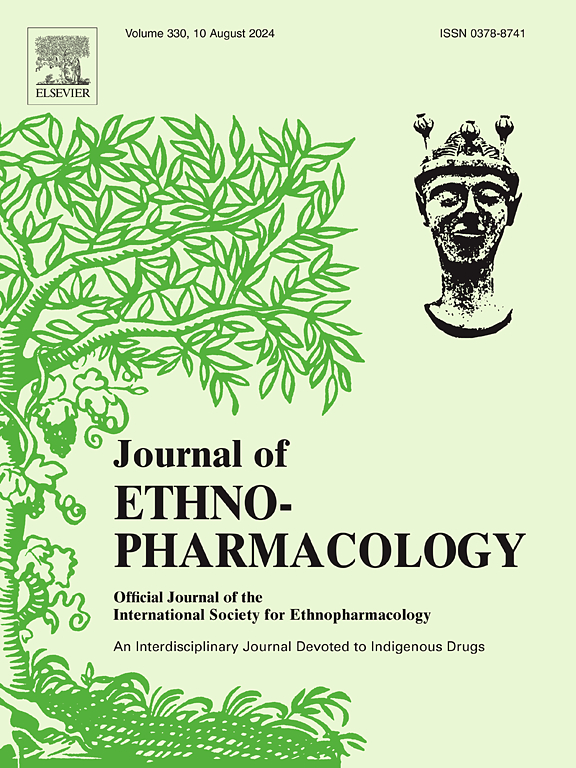麝香保心丸通过抑制KMT5A介导的Irf7转录,抑制巨噬细胞介导的炎症,从而缓解动脉粥样硬化
IF 4.8
2区 医学
Q1 CHEMISTRY, MEDICINAL
引用次数: 0
摘要
麝香保心丸(SBP)是由七种中药成分组成的传统复方制剂。尽管收缩压在治疗心血管疾病方面显示出良好的临床效果,但其在缓解动脉粥样硬化中的作用和潜在机制仍未得到充分研究。本研究旨在探讨收缩压在表观遗传调节巨噬细胞炎症反应中减轻动脉粥样硬化的作用及其机制。材料和方法apoe - / -小鼠在不同浓度的收缩压后给予高脂肪饮食(HFD)。采用油红O染色、苏木精-伊红(HE)染色、ELISA法评价收缩压抗动脉粥样硬化和抗炎作用。随后,采用RNA测序(RNA-seq)、RT-PCR、Western blot (WB)、免疫荧光(IF)和染色质免疫沉淀(ChIP)技术在骨髓源性巨噬细胞(bmdm)中阐明SBP减轻巨噬细胞炎症反应的表观遗传机制。赖氨酸甲基转移酶5A (KMT5A)在体内和体外过表达,以进一步验证。结果ssbp通过减少斑块面积、血清炎症水平和主动脉根部和斑块中巨噬细胞的浸润,显著减轻HFD治疗ApoE−/−小鼠的动脉粥样硬化。收缩压治疗降低了氧化低密度脂蛋白(oxLDL)治疗后bmdm的炎症反应。机制上,舒张压通过降低kmt5a介导的组蛋白H4赖氨酸20 (H4K20)的单甲基化来抑制干扰素调节因子7 (IRF7)的表达,从而减少多种促炎细胞因子的分泌,包括干扰素(IFN)-α、IFN-β、TNF-α。KMT5A过表达可消除收缩压的抗动脉粥样硬化和抗炎作用,进一步证实KMT5A/H4K20me/IRF7轴是收缩压发挥治疗作用的关键靶点。结论舒张压通过下调H4K20甲基化酶KMT5A抑制巨噬细胞炎症反应,从而抑制Irf7的转录,发挥抗动脉粥样硬化作用。我们的发现为收缩压减轻动脉粥样硬化提供了一种新的表观遗传机制。本文章由计算机程序翻译,如有差异,请以英文原文为准。

Shexiang Baoxin Pill alleviates atherosclerosis by inhibiting macrophage-mediated inflammation via suppressing KMT5A mediated Irf7 transcription
Ethnopharmacological relevance
Shexiang Baoxin Pill (SBP) is a traditional compound formulation composed of seven Chinese medicinal ingredients. Although SBP has shown promising clinical outcomes in the treatment of cardiovascular diseases, its role and underlying mechanisms in alleviating atherosclerosis remain insufficiently studied.
Aim of the study
This study aims to investigate the effects and mechanisms of SBP in epigenetic modulating macrophage inflammatory responses to mitigate atherosclerosis.
Materials and methods
ApoE−/− mice were treated with high fat diet (HFD) following varying concentrations of SBP. Oil Red O staining, hematoxylin-eosin (HE) staining, and ELISA were used to assess the anti-atherosclerotic and anti-inflammatory efficiency of SBP. Subsequently, RNA sequencing (RNA-seq), RT-PCR, Western blot (WB), immunofluorescence (IF) and chromatin immunoprecipitation (ChIP) were employed in bone marrow derived macrophages (BMDMs) to elucidate the epigenetic mechanisms of SBP in alleviating macrophage inflammatory responses. Lysine methyltransferase 5A (KMT5A) was overexpressed in vivo and in vitro for further validation.
Results
SBP significantly attenuated atherosclerosis in HFD treated ApoE−/− mice by decreasing plaque areas, serum inflammation levels and macrophages infiltration in the aortic root and plaques. SBP treatment reduced BMDMs inflammatory responses following oxidized low-density lipoprotein (oxLDL) treatment. Mechanistically, SBP inhibited interferon regulatory factor 7 (IRF7) expression by reducing KMT5A-mediated mono-methylation of histone H4 lysine 20 (H4K20), thus decreasing the secretion of multiple pro-inflammatory cytokines, including interferon (IFN)-α, IFN-β, TNF-α. Overexpression of KMT5A abolished the anti-atherosclerotic and anti-inflammatory effects of SBP, further confirming that KMT5A/H4K20me/IRF7 axis is a key target for SBP exerting therapeutic effect.
Conclusion
SBP exerts anti-atherosclerotic effects by inhibiting macrophage inflammatory responses through downregulation of the H4K20 methylase KMT5A, thereby suppressing the transcription of Irf7. Our findings provide a novel epigenetic mechanism by which SBP alleviates atherosclerosis.
求助全文
通过发布文献求助,成功后即可免费获取论文全文。
去求助
来源期刊

Journal of ethnopharmacology
医学-全科医学与补充医学
CiteScore
10.30
自引率
5.60%
发文量
967
审稿时长
77 days
期刊介绍:
The Journal of Ethnopharmacology is dedicated to the exchange of information and understandings about people''s use of plants, fungi, animals, microorganisms and minerals and their biological and pharmacological effects based on the principles established through international conventions. Early people confronted with illness and disease, discovered a wealth of useful therapeutic agents in the plant and animal kingdoms. The empirical knowledge of these medicinal substances and their toxic potential was passed on by oral tradition and sometimes recorded in herbals and other texts on materia medica. Many valuable drugs of today (e.g., atropine, ephedrine, tubocurarine, digoxin, reserpine) came into use through the study of indigenous remedies. Chemists continue to use plant-derived drugs (e.g., morphine, taxol, physostigmine, quinidine, emetine) as prototypes in their attempts to develop more effective and less toxic medicinals.
 求助内容:
求助内容: 应助结果提醒方式:
应助结果提醒方式:


